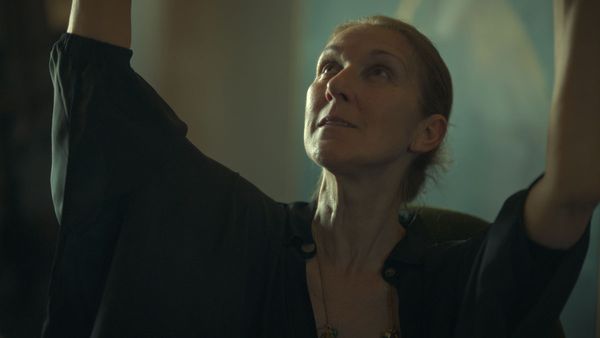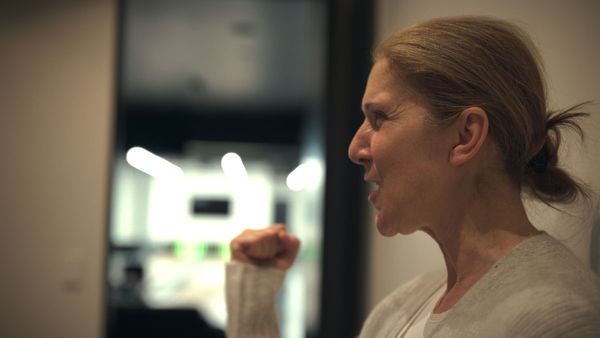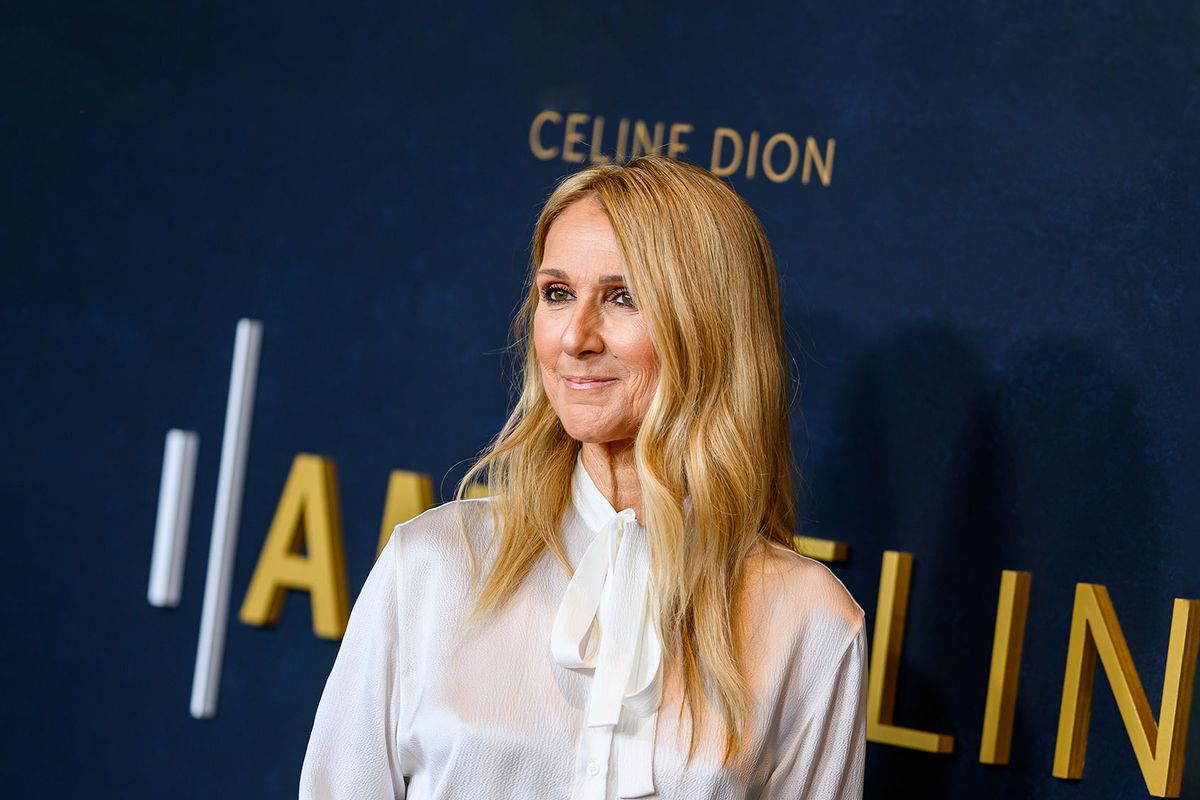Filmmaker Irene Taylor learned a significant lesson from her mother, who is deaf, but loved to sing to her. "She didn't hit the notes, but she had a cadence and she had a rhythm that told me at a very early age that music is love."
Her observation comes as part of the opening remarks at the Manhattan premiere of "I Am: Celine Dion," Prime Video's documentary which illuminates the professional trajectory and resilience of powerhouse performer Celine Dion, for which Taylor served as director.
"We're going to see a lot more from Celine."
"I Am: Celine Dion" comes at a unique juncture in the "My Heart Will Go On" singer's life and career. In August of 2022, she was diagnosed with Stiff Person Syndrome (SPS), a rare and progressive autoimmune neurological condition that causes muscular rigidity and intermittent spasms. The disorder has traumatized the Canadian singer's vocal abilities — in a recent "Today" interview, Dion revealed that singing with SPS feels "like somebody's strangling you."
Dion herself appeared at the screening and said that the project is meant to serve as a love letter to fans by revealing the truth of her new reality. When it came to depicting Dion's situation, Taylor strived to create something that was both relatable and understandable, a simplicity that is largely conveyed in the film's explicit focus on Dion's testimony alone, devoid of the usual documentary talking heads. That also meant showing the more distressing aspects of the singer's disease.
"You really can do that a lot better if you aren't being so opaque and poetic about it," Taylor told Salon. "If you see it, there can be a value in that."
Check out the full interview, in which Taylor discusses her disability advocacy through film, Dion's lifelong love of singing and how that passion, despite playing out somewhat differently from how it used to, is as strong as ever.
The following interview has been edited for length and clarity.
 I Am: Celine Dion (MGM/Prime Video)
I Am: Celine Dion (MGM/Prime Video)
Watching the documentary, I was really intrigued because I felt like I saw Celine's story very much as an athlete who is now suddenly faced with a disability.
So much of her essence is based on her vocals, but also we see all these clips of her on stage really commanding such an athletic presence. We even see that she has her sports medicine doctor, Terrill Lobo, working with her later on as she's dealing with SPS. I was wondering how that knowledge of her athleticism and her physicality as a performer affected how you approached "I Am: Celine Dion?"
That's such an astute observation, yeah. So it was very easy to think about her physicality because nearly every day I was there filming with her, at some point in the day we would film her physical therapy, because it's something she does six days a week. So it was very easy to see that she had good days and bad days. It was very easy to think about all of those archival moments in her concerts where she is just leaping across the stage and she's energetic. There are lots of little small moments I like to pull out of some of those performances, not to give you a fan moment, but to contrast the woman we're seeing now. And it's not that she looks bad or unhealthy, but she's more tentative, right? She was so commanding on stage, and I think that was very hard on her just to be less coordinated than she once was, to be less flexible than she once was.
I think her body and her vocal cords and her diaphragm are part of that body, right? They served her well, and she took very good care of herself. She talks about her prescription drug use, but it wasn't to feel relaxed or because she has an addictive personality, I think really she was doing it to walk, to just function, and that's how bad it got, and I think that's hard on someone. We see that with athletes who, by 30, they're already having trouble and they've really got to think about what they want to do with the rest of their lives. I think it's not too different in Celine's case because she was so physical.
Totally. You have a personal relationship with disability that you shared with the audience last night. What are the misconceptions that people have about those who cannot see or hear as well in their appreciation for music and performance specifically?
Well, I think that a lot of people just — to give the greater society the benefit of my doubt — I think that a lot of people just don't realize how the senses can be. If you don't have vision, you can develop other senses that you have in a more acute capacity, and it gives what I would call a superpower.
I made one of my documentaries about my son, and my son is deaf. My parents are deaf, and also my son is deaf, and I made the film because I realized that we always say about Beethoven, for example, "Well, Beethoven was such a good musician in spite of his deafness." Well, I would say he was a great musician because he developed deafness, and that was his journey.
Your film "Moonlight Sonata," right?
This is "Moonlight Sonata," yeah. So I think we're going to see a lot more from Celine, and we're going to see more from her, not because she's going to be back to normal or back to the old Celine — it's because we are going to see a woman who has a very powerful will, a very iconic voice, a deep love for music and for singing. We're just going to see her adapt, and we're going to see what comes out of that. It may be that her repertoire changes so that her vocal range is not as great, but she's singing with more intensity and more emotion, if that's even possible for Celine, because she's already so intense and emotional. But we will see what is possible.
"You're not going to forget it."
And I think that disability is often seen on a ledger of life. It's a debit instead of a credit. And I think that's just something that slowly, in my filmmaking, I would like to contribute to changing that perspective. And I'm not on a soapbox. I'm not trying to make issue-based films about disability, but I do like to choose my characters carefully, because I see them as a tool for us to all think about our own abilities and our own disabilities, you know, separately.
There were a range of performance clips that showed both Celine's vocal acrobatics, but also her full-body performances, as we just mentioned. There were also clips where the lyrics seemed to reflect the part of her life being described on screen when she discusses the death of her husband René Angélil. For example, we see her singing "All By Myself." How many hours were spent deciding which of these to feature and where? I thought that was really interesting, the way that you put that together.
Well, I think that particular example, I would say, was very on the nose, right? Almost so on the nose that I wasn't sure I wanted to do it. But two things I'll say: That actual performance where she cries singing that song was the first time she went live after René died. So not everyone's going to know that. Some super fans are going to know that. But it was a real moment for her. Like, she really was expected to sing that song because it's a hit. So she's going to sing it. But of course, now it took on a whole new meaning. So that was the first reason I was OK to include something like that.
But I think if I'm going to include things that are that on the nose, they're too easy, right? They're very low-hanging fruit, you could say, creatively. But I think I tried to do the opposite, where I would show a series of pictures with no audio, with no context. And you sort of let your brain fill in the blank with your imagination. And so I really tried to just change it up a lot so that it wasn't too obvious. But I also didn't want to make a film that was so avant-garde that it wasn't relatable, right? So that's why I kind of tried to do that. And I give my editors a lot of credit. They really had just such genius ideas about how we could play with time in one single scene. And it was a way to show her [Celine's] kindness, but also a certain vulnerability, that even after 40-some-odd years, she's still spraying a little perfume on, just because it gives her a little pick-me-up even though she's just doing a virtual interview.
Celine loves shoes, as we see in the documentary. She goes on a spiel about it, which I thought was one of the funniest moments of the film. Could you discuss including that scene, along with her gigantic, motorized closet of shoes?
Well, I have to confess, I love shoes, too. So when I first saw her closet, which was that beautiful bedroom that we spent many hours in, I saw it as a still life. And then there's a funny archival scene where Celine uses a remote control to move shoes back and forth in parts of her closet. And I think that I really tried to look at this and have some compassion for someone who, OK, so she loves her shoes — but she also needs shoes that she can dance in. She needs shoes that she can feel good in. And as she puts it, "I walk the shoe, the shoe doesn't walk me." She wants to be in command, and certain shoes make her feel a certain way.
They're also a very practical thing. It was a very subtle little moment, but she says, "I have no low-heeled shoes, but I can't wear open-toed shoes because there might be paparazzi." What does she mean by that? Because she might have to run. I mean, that's the life that she was living. And so ordinary people like you and I, we don't think about things like that. We're like, "Do I want to see my toes today or don't I want to see my toes today?" (laughs) But for her, it was like a safety issue.
 I Am: Celine Dion (MGM/Prime Video)Toward the end of the documentary, we see Celine experience a severe spasmodic episode from SPS. That was very deeply moving. It was incredibly emotional to watch — I was crying. What were the challenges in showing such a deeply personal moment?
I Am: Celine Dion (MGM/Prime Video)Toward the end of the documentary, we see Celine experience a severe spasmodic episode from SPS. That was very deeply moving. It was incredibly emotional to watch — I was crying. What were the challenges in showing such a deeply personal moment?
Well, first of all, the challenge I had was that I was filming it with my director of photography. I was the sound person and he was the camera person, and we were two feet from her head the entire time it was happening because we were caught in the corner of her physical therapy room and we didn't want to get in anyone's way. So we pretty much just moved our perspective by 30 or 40 degrees –that's it – the whole time. And so as a human being, I first needed to make sure that she could breathe. And I wasn't even clear that she was breathing. I was pushing my headphones against my ears so that I could pick up the sound of her breath from the microphone. And I didn't hear it. And I was extremely uncomfortable and I was very upset. But the thing is, there were several other people in the room whose job it was, and they were much more qualified than me to deal with the matter at hand. They had training, they knew what to do.
So as I did with everything we filmed, I kept filming. I had been filming for eight months at that point. I kept filming. I knew she would want me to keep filming. And I knew that she would trust that if she decided that was too much, she might ask to see the footage and decide that she didn't want to see it in the film. So as a filmmaker, I didn't hesitate to film it. As a human, I hesitated to make the filming my first priority. My first priority was definitely, "Is she OK?" And if she's not, I'm going to drop the microphone and my cameraman's going to put the camera down and we are going to run to the hospital, do whatever we need to do.
"She questions who Celine Dion really is. Is Celine Dion still existing?"
But it wasn't necessary because she had people there. And I think ultimately, as a storyteller and as an advocate — getting back to the disability question — as someone who feels like I am intrinsically advocating for people to understand what it's like to live in the body of someone with a disability or with a chronic illness or with a sensory difference, you really can do that a lot better if you aren't being so opaque and poetic about it. If you see it, there can be a value in that. But seeing too much of it, I mean, I'm sorry that you said you cried. I really am. And I know that not everyone is going to feel good in that moment, but you're not going to forget it. And I could have given you 50 minutes of it and instead, I gave you five. So she was experiencing it for 50.
And I will tell you one other thing I did think about was that I know that Celine is only semi-conscious when these things happen. She doesn't know what it looks like. She can't see herself. And I thought she might just want to know. And if she doesn't, no problem. I won't show it to her. But she did not ask me to include it. She did not ask me not to include it. And so the first time she saw it was in an edited form in the film that I showed her. And she specifically said, "Don't take one second away." So we kept it in.
Celine at one point talks about her voice being the conductor of her life and taking the reins. Now her voice is being taken away from her. At what point did you know that this was a sort of rumination on identity as a project? And when was the film's title first realized?
Pretty late. I came up with the title "I Am" pretty late. But it did have to do with two moments in the film. One is when she is talking about her childhood with her family being the youngest of 14 kids. And she's basically making the point, "I didn't make this up. This is who I am. I've always been this way." And she talks about her personality as a child. And she talks about how her mother taught her to be a performer and be a professional. And she is, she was that person. She still is that person. So she literally says the phrase, "I am, I am this way. This is who I am."
There's a second thing when she, towards the end of the film, after she has this extraordinarily excruciating medical episode, she hears one of her favorite songs, which is a song called "Who I Am." And it was not lost on me that she didn't quite know all the lyrics. And it's sweet. You see her flubbing the lyrics a little bit. But man, when that refrain comes in, she knows exactly what the lyrics are. "Who I am, who I am, who I am. This is who I am."
And so I thought she also really commands a strong title of the film. And there was conversation in my brain a lot whether to include her name in the film. Because she questions who Celine Dion really is. Is Celine Dion still existing? Because her voice can no longer be the conductor. But I actually think she's realizing, and I certainly feel this way, her voice can still be a conductor. She's just going to sing differently.
"I Am: Celine Dion" is streaming on Prime Video on June 25.



Shares